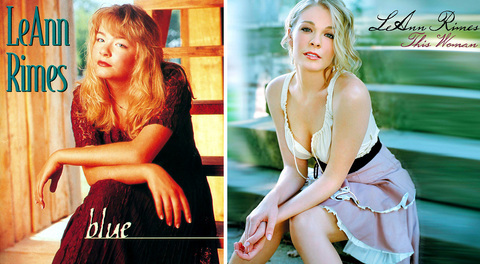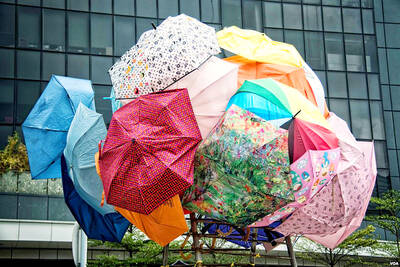As fans of the 22-year-old singer Miranda Lambert will recognize, she is as authentically East Texas as a girl can get. Lambert, whose Kerosene album was this year's top-selling country debut, was born in Lindale, population 2,500, the daughter of a country songwriter and a private detective. She has blond hair and pillow lips and wears mostly shredded jeans and ripped T-shirts, practically a character from a Larry McMurtry novel.
Lambert thinks of herself as giving a little edge to country. When she mentions a favorite designer label, Imitation of Christ -- a reactionary collection known for hand-shredded T-shirts with subversive messages, an unlikely choice in her neck of the woods -- the name rolls off her tongue in an accent as sweet and Southern as graham cracker pie.
"I have my own little sense of style," Lambert said. "As far as image goes today for a new artist, you'll find that fashion is really important. I wouldn't want to show up for a performance in something that is absolutely the opposite of who I am as an artist."

PHOTO: NY TIMES NEWS SERVICE
For Lambert and the leading female stars of today's country music scene, women like LeAnn Rimes, Martina McBride and Faith Hill, the concept of high fashion and red carpets is now as old hat as the 10-gallon variety. These women buy their boots at Versace and Dolce & Gabbana, not Tony Lama, and they do not leave price tags dangling from their straw hats a la Minnie Pearl. As country music has gone mainstream in the last decade, so has its style.
This gussying up of country meant that New York City is not in danger of a stampede of cowboy boots and bolo ties when the Country Music Awards arrived at Madison Square Garden on Tuesday, after 38 years in Nashville, Tennessee, where they began in 1967.
Joan Rivers said she does not expect many fashion disasters at the awards show and was having a hard time coming up with material that felt fresh. "I've been singing Stand by Your Manicurist all day," she said.
"It makes me sad in a way that the ladies of country are discovering Manolo Blahnik, Jimmy Choo and Stuart Weitzman," Rivers said. "They once were coming in dresses that made them look like they were ready to square-dance. Now it's all about fashion and New York."
But like Rivers, some country artists are concerned that by packaging themselves in designer gowns, they may also be abandoning a tradition of Western attire that helped define a genre for much of the 20th century.
"Country is not something you put on and take off," Womack said in response to the pressure to dress for the red carpet. "When the Dixie Chicks first came out and people said they don't look country, that bothered me. You can't get more countrier than me."
But younger stars have embraced big city designers and consider a stylish wardrobe to be part of the package they are selling to the public. Rimes, 23, and Julie Roberts, 26, grew up with a taste for designer gowns and acquired a more mainstream style by watching fashion coverage from Hollywood awards shows on television and in magazines.
"I had a stylist from the time I was 13," Rimes said. To trace her career through her album covers, from the release of Blue in 1996 to her current incarnation on This Woman, is to witness her transformation from a chubby teenage beauty-queen contestant into a sultry young woman with a heaving bosom in a lace camisole.
"The big misconception is that we're all about cowboy hats and boots," Rimes said. "I love Urban Outfitters and Abercrombie & Fitch for everyday, but when I found out there was other stuff out there and designers who would lend you dresses from the couture, dressing up became my favorite part of the job. I fell in love with clothes."
So did Roberts, who was born in Lancaster, South Carolina, and now lives in Nashville. Last week she was working with a stylist, Claudia Fowler, to select a gown, trying to decide between designs by Dolce & Gabbana, Giorgio Armani, Kaufman Franco and Jean Paul Gaultier. "I don't know if I'm saying this right," Roberts said. "Is it Go-tee-yay?" She was close enough.

Water management is one of the most powerful forces shaping modern Taiwan’s landscapes and politics. Many of Taiwan’s township and county boundaries are defined by watersheds. The current course of the mighty Jhuoshuei River (濁水溪) was largely established by Japanese embankment building during the 1918-1923 period. Taoyuan is dotted with ponds constructed by settlers from China during the Qing period. Countless local civic actions have been driven by opposition to water projects. Last week something like 2,600mm of rain fell on southern Taiwan in seven days, peaking at over 2,800mm in Duona (多納) in Kaohsiung’s Maolin District (茂林), according to

It’s Aug. 8, Father’s Day in Taiwan. I asked a Chinese chatbot a simple question: “How is Father’s Day celebrated in Taiwan and China?” The answer was as ideological as it was unexpected. The AI said Taiwan is “a region” (地區) and “a province of China” (中國的省份). It then adopted the collective pronoun “we” to praise the holiday in the voice of the “Chinese government,” saying Father’s Day aligns with “core socialist values” of the “Chinese nation.” The chatbot was DeepSeek, the fastest growing app ever to reach 100 million users (in seven days!) and one of the world’s most advanced and

The latest edition of the Japan-Taiwan Fruit Festival took place in Kaohsiung on July 26 and 27. During the weekend, the dockside in front of the iconic Music Center was full of food stalls, and a stage welcomed performers. After the French-themed festival earlier in the summer, this is another example of Kaohsiung’s efforts to make the city more international. The event was originally initiated by the Japan-Taiwan Exchange Association in 2022. The goal was “to commemorate [the association’s] 50th anniversary and further strengthen the longstanding friendship between Japan and Taiwan,” says Kaohsiung Director-General of International Affairs Chang Yen-ching (張硯卿). “The first two editions

It was Christmas Eve 2024 and 19-year-old Chloe Cheung was lying in bed at home in Leeds when she found out the Chinese authorities had put a bounty on her head. As she scrolled through Instagram looking at festive songs, a stream of messages from old school friends started coming into her phone. Look at the news, they told her. Media outlets across east Asia were reporting that Cheung, who had just finished her A-levels, had been declared a threat to national security by officials in Hong Kong. There was an offer of HK$1m (NT$3.81 million) to anyone who could assist